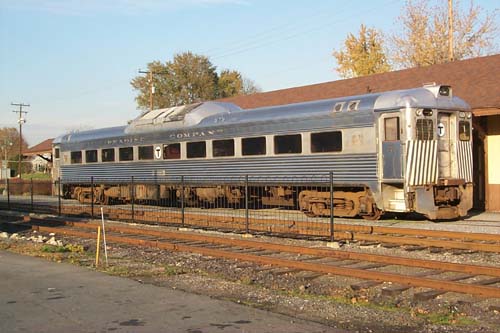Budd Rail Diesel Car
The Budd Rail Diesel Car ( RDC Budd ) is a diesel-hydraulic driven railcars built by the Budd Company 1949-1962 for use on underutilized passenger transport connections.
History
After the end of World War II took Budd Pullman behind a second position on the market for passenger cars and locomotives. Characteristic of Budd were the stainless steel constructions that were used for the first time at the Pioneer Zephyr. For weakly used connections of passenger traffic, was for the still state- imposed traffic duty on the part of the railway companies, the end of the forties was a successor to the so-called " Doodlebugs ", petrol - and diesel-electric railcars from the twenties sought. The Director of Mechanical Engineering at Budd, the former Major General Gladeon Marcus Barnes, had the idea V6 diesel engines, which were used by General Motors to drive tanks to combine with a lightweight stainless steel body. This should result in a slight railcars with a favorable power to weight ratio and resulting good acceleration and deceleration values. The management decided in 1949 to build a prototype to make him the railway companies tasty.
The vehicle proved to be extremely successful until the end of production 1962 398 Rail Diesel Cars were built. The largest operator was the Boston and Maine Railroad with 64 copies. Also in Australia, including on the 1613 km long route between Port PIREE and Kalgoorlie, the Budd RDC was used. With the end of the traffic duty end of the seventies many RDCs were retired, but some are still today, especially in Canada, in use.
Constructive interpretation
The Budd Rail Diesel Car consisted of a stainless steel car body, the abstütze on two -axle bogies. In the center of the car were located under the floor two ( the RDC -9 a ) General Motors six-cylinder diesel engines of type 6-110, each with 205 kW (279 hp), each drives the inner axles of the bogies of hydraulic torque converter and cardan shafts. The top speed was 137 km / h at 20 ‰ slope is still 64 km / h Air -operated disc brakes with anti-skid devices made for short braking distances. Through multiple panel offers a compilation to trains was possible.
Variants
All types were combined freely by the multiple unit control.
Pure persons size with 94 seats
Passenger cars with small luggage compartment, 70 seats
Coaches with luggage compartment and mail compartment, 49 seats
Baggage / railway mail car, only 22.5 m long
Means single-engine cars without tax compartments at the ends










